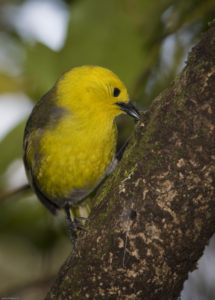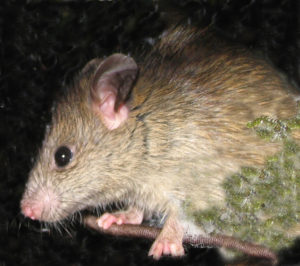The mohua, or yellowhead, is a small bird with a bright yellow head and breast. Early settlers called it the ‘bush canary’ because of its colour and beautiful song.
The mohua’s story is a familiar one, of population decline since the 1800s. In the 1800s, the mohua was one of the most common birds in New Zealand forests. They flocked in large groups and their song could be heard everywhere. By 1900, the mohua was beginning to disappear from our forests. Now, a hundred years later, there are less than 5,000 left. They live in about 30 small groups in the South Island and on Stewart Island.

Mohua eat beetles, caterpillars, spiders and moths. They also eat a small amount of fruit and berries. They like to feed high in the trees, 25-45 metres above the ground. They can’t catch insects while they’re flying, like fantails do. Instead, mohua scramble up and down tree trunks and branches and find insects by picking off bark and moss. They poke their beak into cracks in the bark, looking for grubs to eat and often hang upside down.
Mohua like to look for insects in the leaf litter that gets stuck in the forks of branches. The mohua holds onto the tree bark with one foot, presses its tail feathers into the bark to help it grip, then uses its other foot to scratch the leaf litter and uncover beetles and spiders. Sometimes their tail feathers get so worn down by being used this way that they look like spines.
Mohua nest in tree holes. The female builds a cup-shaped nest of moss, rootlets, twigs and spiders’ webs and lines her nest with fine grass. She lays 3-4 eggs and incubates them for 20 days. She also sits on the chicks to keep them warm once they hatch. The male brings her food while she is sitting. He also helps to feed the chicks.
The parents get extra help in raising their chicks from other mohua. These nest-helpers are often the chicks from the previous year. The parents and their helpers feed the chicks at the nest for 22 days until they are big and strong enough to fly. Once they can fly the chicks follow the adult birds begging for food.
The parents and nest helpers feed the chicks from summer, all through their first winter. Next summer these chicks are the new nest helpers. The male and female parent birds will stay together for many years.
Danger, danger!
Because they build their nest in a tree hole, there is no escape from predators like possums, stoats and rats. Ship rats are excellent climbers. The rats eat chicks and eggs and also adult female mohua that they catch sitting in nest holes incubating the eggs. This is the reason why there are more male mohua than females in high predator areas.
Possums and introduced birds compete with mohua for food. Wasps may also compete with them in beech forests by eating honeydew.
Humans cut down their forests – once mohua lived in podocarp-hardwood forests (such as rimu, totara and miro) but now they’re only found in beech forests with fertile soils where they can find plenty of food. Red beech trees are one of their favourite nest sites.
Big baby!
The long-tailed cuckoo spends its winters on tropical pacific islands, then returns to New Zealand in spring and looks for a mohua or brown creeper nest. It lays one egg in the nest and flies away. When the cuckoo chick hatches it throws the original eggs and chicks out of the nest so that it is the only chick. The mohua parents and their nest-helpers then spend summer raising a very hungry, very large cuckoo chick instead of raising their own family.
Plague!
A predator plague in 2000 caused many mohua deaths. There were population crashes in Canterbury, Otago, Southland and Fiordland. and the Marlborough region probably lost all of its few remaining mohua. Another predator plague caused by high levels of seed production (‘beech mast’) in 2014, put them at risk again.
Good news
There is some good news in the Mohua’s story, they have been bred in captivity at Orana Park in Christchurch.
Mohua have a fairly high reproductive rate. Each year they can lay up to four eggs and once these have hatched and fledged the pair can raise another brood. If the threats to mohua can be reduced so that more chicks survive, then the mohua population has a good chance of recovery.
At the moment, the average life-expectancy of mohua is only 5 years in the wild, but they can live up to 12 years.



